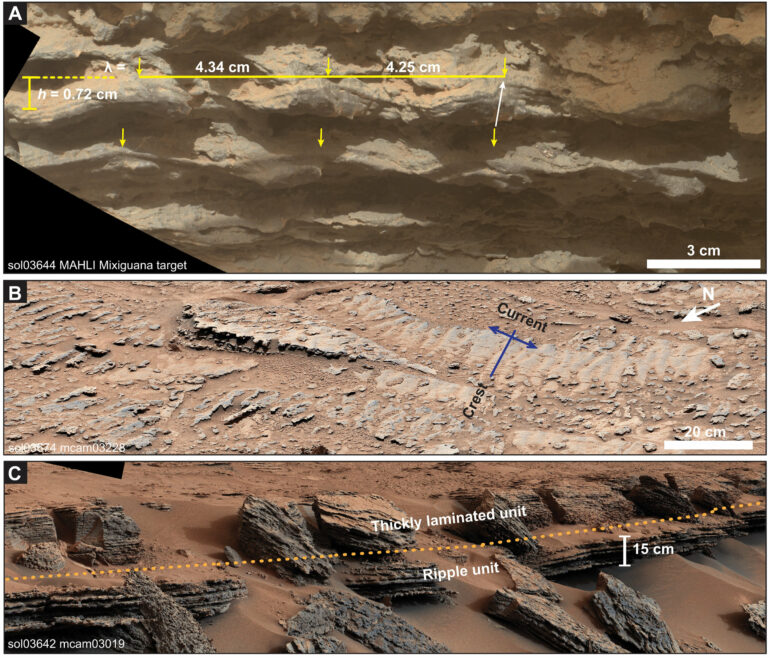Researchers have discovered two sets of ancient wave ripples on Mars, signatures of long-dried bodies of water preserved in the rock record. Wave ripples are small undulations in the sandy shores of lakebeds, created as wind-driven water laps back and forth. The two sets of ripples indicate the former presence of shallow water that was open to the Martian air, not covered by ice as some climate models would require.
Ripples are one of the clearest indicators of an ancient standing body of water that can be provided by the geologic record. The team estimates that the ripples formed around 3.7 billion years ago, indicating that the Martian atmosphere and climate must have been warm and dense enough to support liquid water open to the air at the time.
The research is described in a paper appearing in the journal Science Advances. Caltech’s John Grotzinger, Harold Brown Professor of Geology, and Michael Lamb, professor of geology, are principal investigators on the study.
“The shape of the ripples could only have been formed under water that was open to the atmosphere and acted upon by wind,” says postdoctoral scholar Claire Mondro, the study’s first author.
Lamb, an expert on the interactions between sediment, water, and atmosphere on Earth, created computer models from the ripples to determine the size of the lake that created them. The ripples are small—only about 6 millimeters high and spaced 4 to 5 centimeters apart. Such small ripples in fine sand are formed by the action of small waves, and this constraint limits the original setting to a shallow lake less than about 2 meters deep.
The period of the ripples’ formation, around 3.7 billion years ago, was a time in Mars’s history when it had been assumed that the planet was becoming drier.
“Extending the length of time that liquid water was present extends the possibilities for microbial habitability later into Mars’s history,” Mondro says.
The ripples were discovered in 2022 by NASA’s Curiosity rover as it drove through the Gale Crater region of Mars. One set of ripples, the Prow outcrop, was discovered in a region that once contained wind-blown dunes. The other set, found nearby in the Amapari Marker Band of rock, suggests the presence of a lake with up to 2 meters of water, slightly later in Mars’s history than the Prow. The two sets of ripples suggest that the atmospheric conditions for their formation occurred at multiple points in time.
“The discovery of wave ripples is an important advance for Mars paleoclimate science,” says Grotzinger, the former project scientist for Curiosity’s mission, the Mars Science Laboratory (MSL).
“We have been searching for these features since the Opportunity and Spirit landers began their missions in 2004. Earlier missions, beginning with Opportunity in 2004, discovered ripples formed by water flowing across the surface of ancient Mars, but it was uncertain if that water ever pooled to form lakes or shallow seas.
“The Curiosity rover discovered evidence for long-lived ancient lakes in 2014, and now 10 years later, Curiosity has discovered ancient lakes that were free of ice, offering an important insight into the planet’s early climate.”
More information:
Claire A. Mondro et al, Wave ripples formed in ancient, ice-free lakes in Gale crater, Mars, Science Advances (2025). DOI: 10.1126/sciadv.adr0010
Provided by
California Institute of Technology
Citation:
Signatures of ice-free ancient ponds and lakes found on Mars (2025, January 15)



